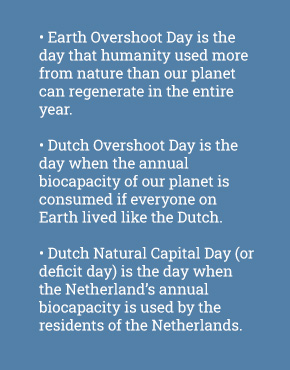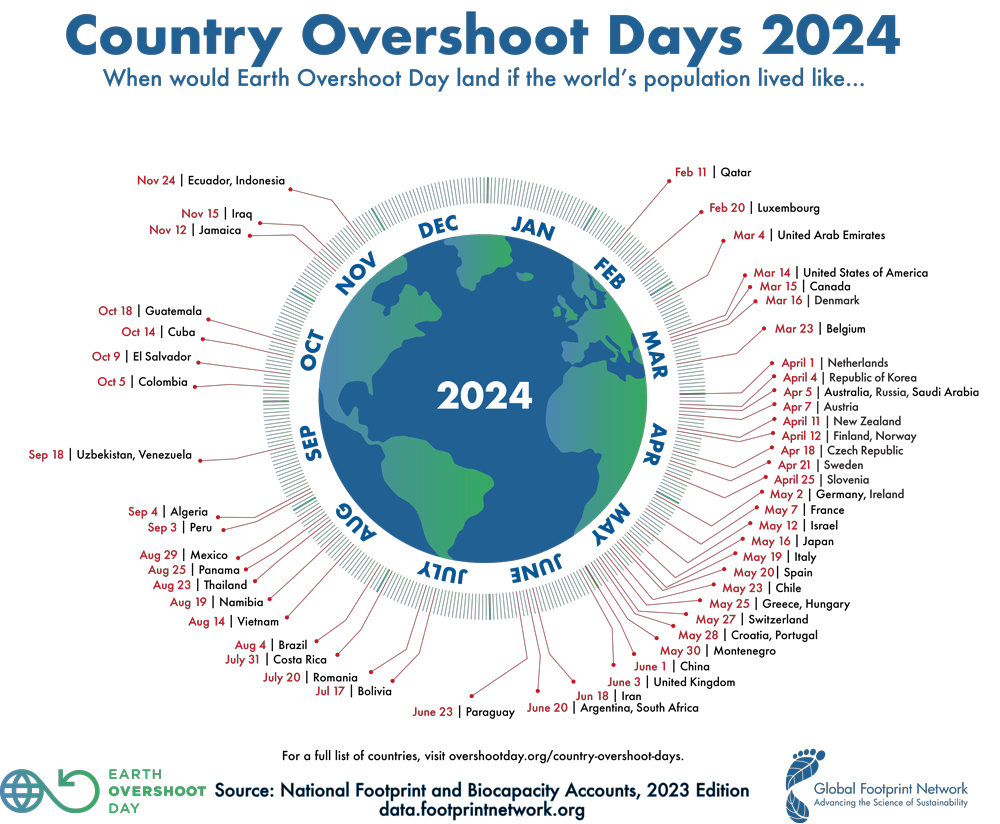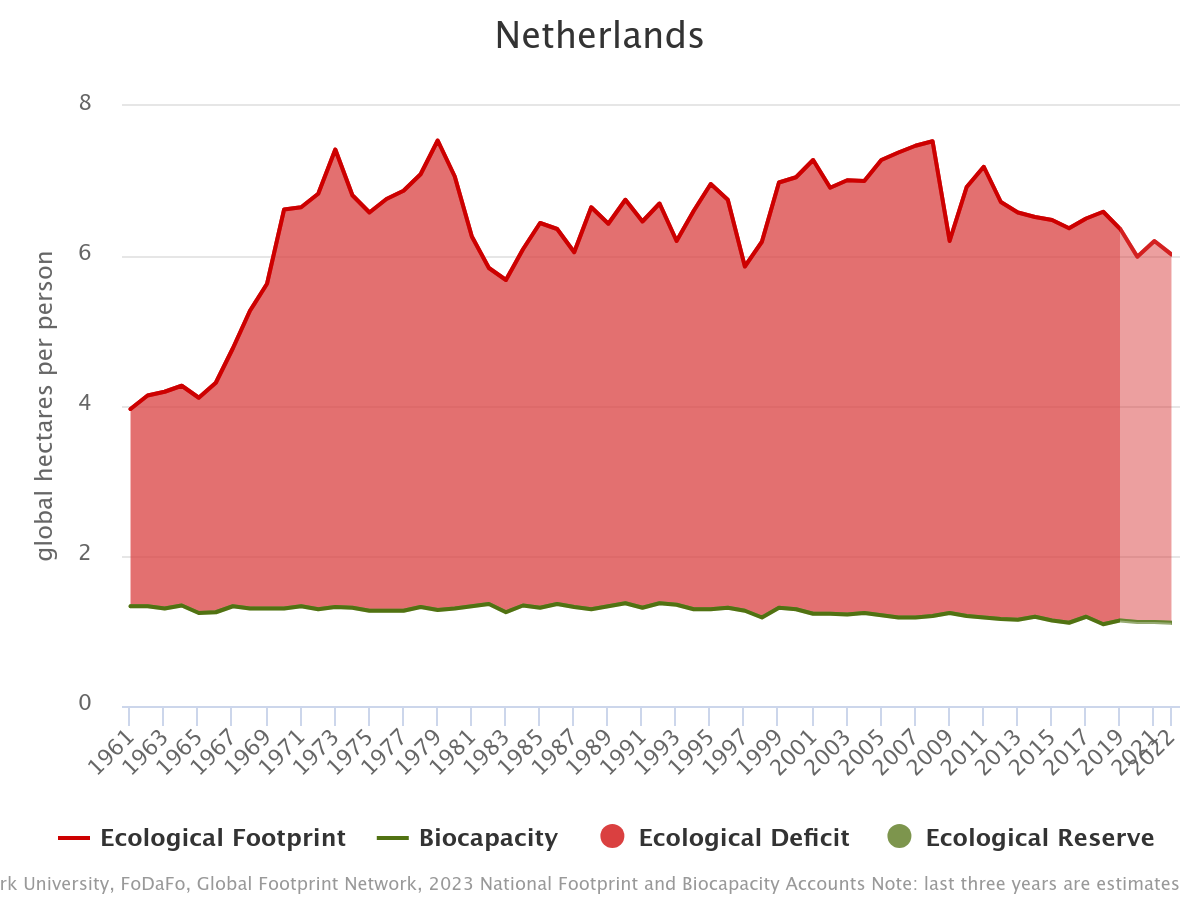This factsheet provides key data about the Netherlands’ ecological performance, based on the National Footprint and Biocapacity Accounts.
This is how these accounts work: human activities compete for nature’s regeneration. Regeneration refers to the ability of ecosystems to constantly renew what is being used or damaged. Examples of human demands are food, timber, fibers for clothes, paper, sequestration for CO2 from fossil fuel burning, or space for roads and houses. Therefore, the world or a country is like a farm: it is possible to assess how much is being regenerated and compare it to how much people demand from the farm.
Biocapacity refers to photosynthetic regeneration by ecosystems. This regeneration is driven by the sun and enables life on our planet. Regeneration produces resources and absorbs waste materials. Regeneration provided by ecosystems is one of humanity’s most critical physical inputs, as it is foundation of all food chains on the planet, including all value chains of the human economy. Ecosystems’ regeneration (i.e., biocapacity) can be compared to human demand on regeneration (i.e., Ecological Footprint).
Natural Capital Day
 By comparing the biocapacity of a country to its residents’ ecological footprint, we can calculate how quickly the country’s biocapacity budget is spent by the country’s population.
By comparing the biocapacity of a country to its residents’ ecological footprint, we can calculate how quickly the country’s biocapacity budget is spent by the country’s population.
Based on the latest available data, the Netherlands contains about 1.1 global hectare of biocapacity per person, while the footprint is 6.0 gha per person. With demand exceeding 6-fold the amount of biocapacity ecosystems in the Netherlands contain, this means that the country’s natural capital or biocapacity budget is exhausted in about 1/6th of the year, i.e., within about 2 months. We call this day the Dutch Natural Capital Day. If the residents’ ecological footprint is bigger than the country’s biocapacity, the country demands more from nature than its own ecosystems can provide:
![]()
Since the Netherlands have less biocapacity per person than the world, the ratio for the world is smaller: If everyone in the world consumed like the Netherlands’ residents, humanity would be using the equivalent of 4 Earths.
Dutch Overshoot Day
Dutch Overshoot Day is the day when the annual biocapacity of our planet is consumed if everyone on Earth lived like the Dutch. For 2024, it falls on April 1st.
We determine the country overshoot days for 2024 using the latest edition of the National Footprint and Biocapacity Accounts available on December 31 of the year prior. This was the 2023 edition, featuring Ecological Footprint and biocapacity data for all countries, from 1961 to 2022, with the last 3 years being estimates because of data lags in UN statistics (Typically, there is a three to four-year lag between the latest data-year and the present due to the UN’s reporting process.)
Here is how the calculation works for the Netherlands:
- The Ecological Footprint for the Netherlands was 6.02 global hectares per person (in 2022)
- Global biocapacity was 1.51 global hectares per person (in 2022)
Therefore, it would take (6.02 / 1.51) = 3.99 Earths if everyone lived like people in the Netherlands,
OR
we can determine the Dutch Overshoot Day as the 366 * (1.58/5.69) = 92nd day in the year. The 92nd day of 2024 is the 1st of April, the Dutch Overshoot Day.

Footprint and Biocapacity of the Netherlands
Between 1961 and 2022, the Netherlands’ total biocapacity (figure 1) has slightly increased, in total, but decreased per person. (as shown in figure below). The Dutch biocapacity is much lower than its Ecological Footprint.

Figure 1: Biocapacity and ecological footprint per person of the Netherlands (1961-2022), 2023 edition of the National Footprint and Biocapacity Accounts
This assessment builds on the 2023 edition of the National Footprint and Biocapacity Accounts. For more detailed analyses, it can be enhanced by Multi-Regional Input-Output assessments. The National Footprint and Biocapacity Accounts are based on about 15,000 data points from United Nations statistics, per country and year. These accounts are is continuously maintained by York University, Toronto, under the governance of Footprint Data Foundation (FoDaFo). Global Footprint Network participates in the governance of FoDaFo.
Resources
- Dutch Overshoot Day 2024 Press Release
- Dutch Overshoot Day 2023 Press Release
- Dutch Natural Capital Day 2022 Press Release
- Country-level Footprint data platform with results for the Netherlands and other countries around the world
- Basic introduction to the Ecological Footprint and biocapacity concepts
- Ecological Footprint and biocapacity data downloads and licenses
- Description of the National Footprint and Biocapacity Accounts accounting methodology
- Wackernagel, M., Hanscom, L., Jayasinghe, P., Lin, D., Murthy, A., Neill, E., Raven, P., 2021. The importance of resource security for poverty eradication. Nature Sustainability. 4, pages 731–738 (2021).


